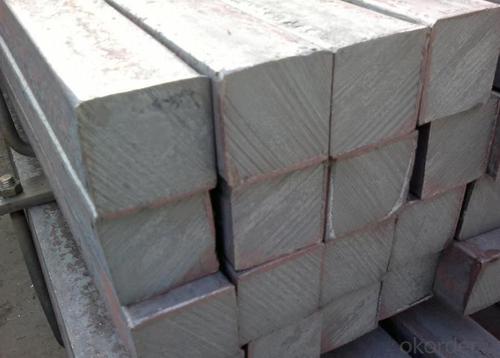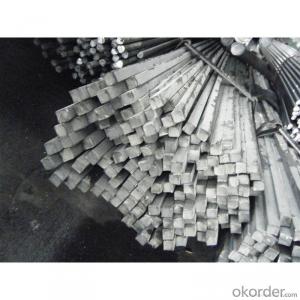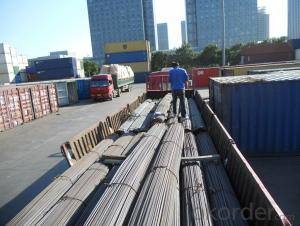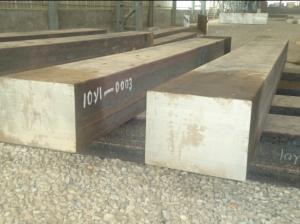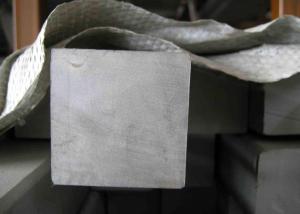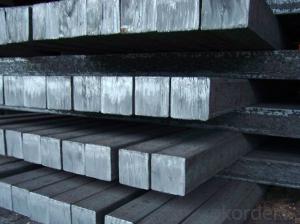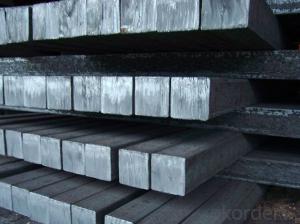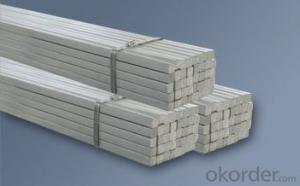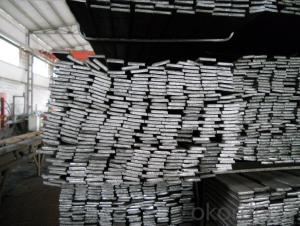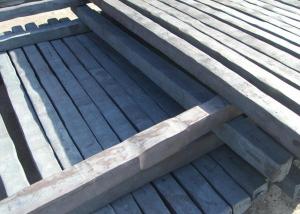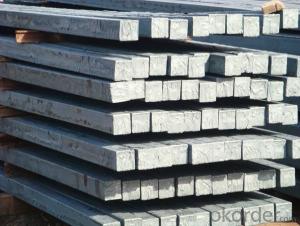HR Square Bar
- Loading Port:
- Tianjin Port
- Payment Terms:
- TT or LC
- Min Order Qty:
- 50Tons m.t.
- Supply Capability:
- 500 tons per month m.t./month
OKorder Service Pledge
OKorder Financial Service
You Might Also Like
Specifications of HR Square Bar:
-Standard: GB,
-Grade: Q195 or equivalent.
-Chemical Composition:
|
Standard |
Grade |
Element (%) | ||||
|
GB |
Q195 |
C |
Mn |
S |
P |
Si |
|
0.06~0.12 |
0.25~0.50 |
≤0.050 |
≤0.045 |
≤0.30 | ||
Measures of HR Square Bar (small measures):

(Section of HR Square Bar)
-Length of a side and Theoretical weight of Square Bar.
|
Length of a side(mm) |
Theoretical weight(kg/m) |
Length of a side(mm) |
Theoretical weight(kg/m) |
|
7 |
0.385 |
22 |
3.80 |
|
8 |
0.502 |
24 |
4.52 |
|
9 |
0.636 |
25 |
4.91 |
|
10 |
0.785 |
26 |
5.30 |
|
11 |
0.950 |
28 |
6.15 |
|
12 |
1.13 |
30 |
7.06 |
|
13 |
1.33 |
32 |
8.04 |
|
14 |
1.54 |
34 |
9.07 |
|
15 |
1.77 |
36 |
10.17 |
|
16 |
2.01 |
38 |
11.24 |
|
17 |
2.27 |
40 |
12.56 |
|
18 |
2.54 |
42 |
13.85 |
|
19 |
2.82 |
45 |
15.90 |
|
20 |
3.14 |
48 |
18.09 |
|
21 |
3.46 |
50 |
19.63 |
Notes:
1, The theoretical weights in the list, base on the density of 7.85 g/cm3.
2, Formula for theoretical weight of Square bar: (length of a side)2 * 0.00785
3, The numbers with *mean that they are not regular or we don’t offer them.
-Regular length of Square Bar:
|
Steel |
Length of a side (mm) |
Length of steel (m) |
|
Normal steel |
< 25 |
4~10 |
|
> 25 |
3~9 | |
|
Steel of high quality |
All measure |
2~6 |
|
Tool steel >75 |
1~6 |
Usage/Applications of HR Square Bar:
-The Square Bar is normally used as structure steel.
-Row material for other structure steel like steel angles, channels, I-beams, H-beams, etc…
Packaging & Delivery of HR Square Bar:
-Packing Detail: The products can be packed in bundles by steel wires.
-Marks: We make tag marks and color marks. The tag marks with white background and red company logo will be tied up to each bundle of the products. The information is usually including basic information of products and company and other information requested by customers. As for color marks, we will paint both ends of bundles to make sure that it will be more convenient for customers to distinguish them from other products.
-Delivery Detail: 30~45 working days after receive buyer’s T.T. or L/C.
Transportation:
-The products can be delivered by bulk vessel or by container. As for container, products with the length of 6m will be loaded in 20’ container, with 9m or 12m, in 40’ container.
-The maximum quantity of loading of container is 25 tons.
-The products are usually transported to the nearest port from the production place.
Photos of HR Square Bar:
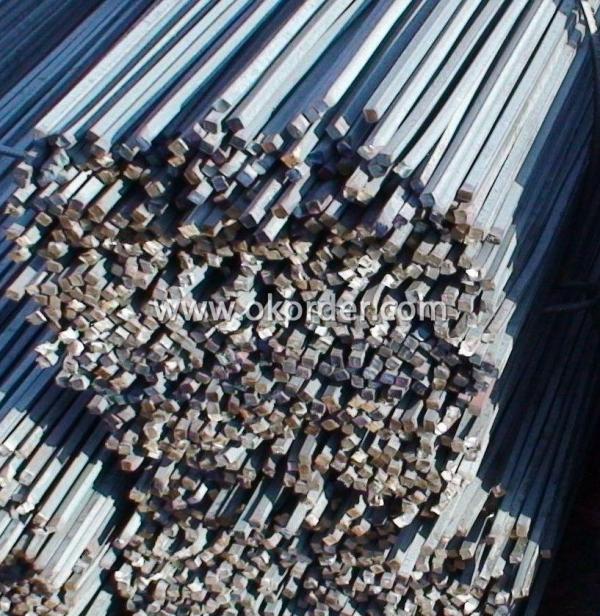
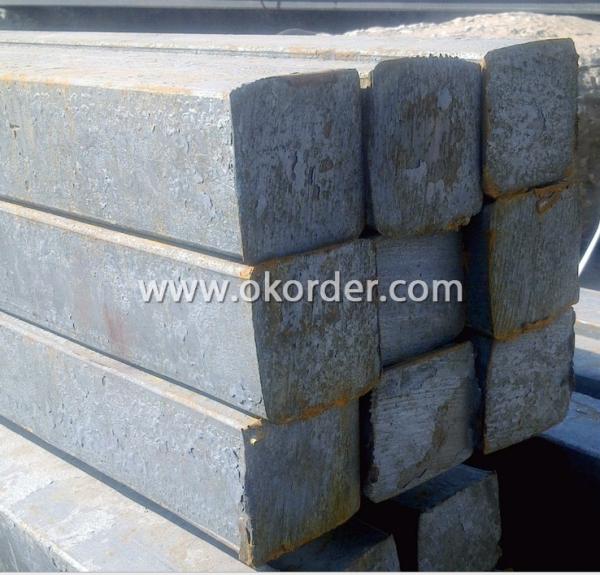
We sincerely welcome partners around the world to establish business cooperation with us on the basis of mutual trust, benefit and development.
- Q: What is the weight of a typical steel square?
- The size and thickness of a typical steel square can cause its weight to vary. Nevertheless, as a rough approximation, a steel square measuring 12 inches on each side and having a thickness of 1 inch can weigh approximately 40 pounds. It should be emphasized that this weight may differ depending on the specific type and grade of steel employed.
- Q: What are the common applications of a steel square in masonry work?
- A steel square, also known as a framing square or carpenter's square, is a versatile tool that is commonly used in masonry work. It can be used for various tasks, including measuring, marking, and cutting materials. One of the common applications of a steel square in masonry work is for laying out and checking right angles. Masons often use the square to ensure that corners are perfectly square, which is crucial for achieving proper alignment and stability in masonry structures. They can place the square against the corner of a wall or foundation to check if it forms a 90-degree angle. If it doesn't, adjustments can be made to ensure the accuracy of the construction. Another common use of a steel square in masonry work is for making precise measurements. The tool has markings along its blade and tongue, allowing masons to measure various dimensions accurately. They can use it to measure the length and width of bricks or blocks, ensuring that they are of the desired size and shape. In addition, a steel square can be used for marking lines on masonry materials. Masons often need to mark cut lines or reference lines on bricks, blocks, or other materials before cutting or installing them. The square's straight edge can be aligned with the desired line, and a pencil or scribe can be used to mark the material accurately. Furthermore, a steel square can also be utilized as a cutting guide. Masons sometimes need to make straight cuts on bricks or blocks to fit them into specific spaces. The square can be used as a guide for a masonry saw or chisel, ensuring that the cut is straight and precise. Overall, the common applications of a steel square in masonry work include checking right angles, making measurements, marking lines, and serving as a cutting guide. Its versatility and accuracy make it an essential tool for masons, enabling them to achieve precise and high-quality masonry construction.
- Q: How do you use a steel square to lay out a cone shape?
- To use a steel square to lay out a cone shape, you can start by marking the desired height of the cone on a flat surface. Then, using the square, align one edge with the marked point and pivot the square until the desired base diameter is achieved. Once aligned, trace along the square's edge to create the outline of the cone shape.
- Q: What are some common applications for a steel square in roofing installations?
- A steel square, also known as a framing square or carpenter's square, is a versatile tool commonly used in roofing installations. It has a wide range of applications that help ensure accurate measurements and precise angles, resulting in a well-crafted roof. Here are some common applications for a steel square in roofing installations: 1. Determining roof pitch: One of the primary uses of a steel square in roofing is to determine the pitch or slope of the roof. The square has markings and graduations that allow roofers to measure and calculate the pitch accurately. 2. Laying out rafters and cuts: Roofers use a steel square to lay out and mark the cuts for rafters, hips, and valleys. It helps them determine the correct angles and lengths for each rafter, ensuring a proper fit and structural integrity. 3. Creating bird's mouth cuts: A bird's mouth is a notch cut into the rafter, allowing it to sit securely on the top plate of the wall. A steel square helps roofers accurately mark and cut these notches, ensuring a tight and secure fit. 4. Checking for squareness and alignment: Roofers use a steel square to check the squareness and alignment of the roof structure. They can measure and verify that corners and edges are perfectly square, which is crucial for a well-balanced and visually appealing roof. 5. Marking and cutting roof sheathing: Roof sheathing, such as plywood or oriented strand board (OSB), needs to be accurately cut and fitted. A steel square helps roofers mark and cut the sheathing to the correct dimensions, ensuring a tight and seamless installation. 6. Determining rafter lengths and spacing: By using the measurements and angles on a steel square, roofers can calculate the correct lengths and spacing for rafters. This helps ensure that the roof structure is stable and can support the weight of the roofing materials. 7. Checking and marking for valleys and hips: A steel square is invaluable when marking and cutting valleys and hips, which are the angled intersections between roof sections. It helps roofers accurately measure and mark these areas, ensuring precise cuts and a seamless transition between roof sections. Overall, a steel square is an essential tool in roofing installations. It enables roofers to measure angles, mark cuts, determine pitch, and ensure accurate alignment. By using a steel square, roofers can achieve a professionally installed roof that is structurally sound and aesthetically pleasing.
- Q: Can a steel square be used for checking the alignment of fence posts?
- Yes, a steel square can be used for checking the alignment of fence posts. The square can be used to ensure that the posts are placed at right angles to the ground, which helps in maintaining a straight and sturdy fence line.
- Q: How do you use a steel square to measure and mark irregular angles?
- To use a steel square to measure and mark irregular angles, you need to follow a few steps. First, position the steel square against the angle you want to measure, making sure one edge of the square aligns with one side of the angle. Next, tighten the square against the angle by holding it firmly in place. Once the square is secure, look at the markings on the square's body. These markings typically include degrees or angles, allowing you to accurately measure the angle you are working with. Align the appropriate marking on the square with the other side of the angle, and take note of the measurement. To mark the irregular angle, you can use a pencil or a scribe tool. Hold the square against the angle, aligning the desired measurement with the other side of the angle. With the square in place, use the pencil or scribe tool to mark the angle on the material you are working with. Be sure to hold the square steady while marking to ensure accuracy. If the angle you are working with is particularly complex or irregular, you may need to use additional tools or techniques to accurately measure and mark it. In such cases, consulting a professional or referring to specific resources for measuring irregular angles can be helpful.
- Q: Can a steel square be used for measuring angles in welding?
- Yes, a steel square can be used for measuring angles in welding. A steel square is typically L-shaped and has a 90-degree angle, making it an appropriate tool to measure and verify right angles in welding. It can be used to ensure accuracy and precision when welding joints and corners.
- Q: Can a steel square be used for checking the squareness of a picture frame miter joint?
- Yes, a steel square can be used for checking the squareness of a picture frame miter joint. A steel square is a useful tool for verifying the accuracy and precision of different angles and joints. By placing the steel square against the miter joint, one can determine if the angle is exactly 90 degrees or not. If the joint is perfectly square, the steel square will align perfectly against both sides of the joint. However, if the joint is not square, the steel square will not align properly, indicating that adjustments need to be made to achieve a perfect 90-degree angle. Therefore, a steel square is an effective tool for ensuring the squareness of a picture frame miter joint.
- Q: Can a steel square be used for checking the squareness of window jambs?
- Yes, a steel square can be used for checking the squareness of window jambs. The straight edges and right angles of a steel square make it a reliable tool for measuring and verifying the squareness of window jambs.
- Q: What are the different techniques for using a steel square in woodworking joinery?
- There are several techniques for using a steel square in woodworking joinery, each serving a specific purpose in achieving accurate and precise measurements and angles. Here are a few commonly used techniques: 1. Checking for squareness: One of the primary uses of a steel square is to ensure that the corners of a joint or workpiece are perfectly square. To do this, you can place the square against the edge of the workpiece and check if the adjoining edge is perpendicular to it. This technique is crucial for creating strong and stable joints. 2. Marking 90-degree angles: When you need to mark a 90-degree angle on a workpiece, a steel square comes in handy. Place the square against the edge of the workpiece and trace along the inside edge of the square with a pencil or marking knife. This technique ensures consistent and accurate marking for precise joinery. 3. Marking angles other than 90 degrees: Steel squares often come with additional markings that allow for the measurement and marking of angles other than 90 degrees. By aligning the desired angle measurement with the edge of the workpiece, you can accurately mark the angle needed for complex joinery. 4. Determining plumb and level: Steel squares can be used to check if a workpiece is plumb (vertical) or level (horizontal). By holding the square against the edge of the workpiece and using a spirit level or plumb bob, you can ensure that your project is properly aligned. 5. Transferring measurements: Steel squares can also be used to transfer measurements from one workpiece to another. By aligning the square against the edge of the first workpiece and marking the desired measurement, you can then transfer that measurement to the second workpiece using the square as a guide. 6. Creating mitered corners: When working with mitered corners, a steel square is essential for ensuring accurate angles. By placing the square against the workpiece and aligning it with the desired angle, you can mark and cut the joint precisely, resulting in clean and tight mitered corners. In summary, the steel square is a versatile and valuable tool for woodworking joinery. Whether you need to check for squareness, mark angles, determine plumb and level, transfer measurements, or create mitered corners, the steel square provides the precision and accuracy required for successful woodworking projects.
1. Manufacturer Overview
| Location | Renqiu, China |
| Year Established | 1996 |
| Annual Output Value | Above US$ 30 Million |
| Main Markets | Mid East; Southeast Aisa |
| Company Certifications |
2. Manufacturer Certificates
| a) Certification Name | |
| Range | |
| Reference | |
| Validity Period |
3. Manufacturer Capability
| a) Trade Capacity | |
| Nearest Port | Tianjin; |
| Export Percentage | 20% - 30% |
| No.of Employees in Trade Department | 11-20 People |
| Language Spoken: | English; Chinese |
| b) Factory Information | |
| Factory Size: | Above 70,000 square meters |
| No. of Production Lines | 1 |
| Contract Manufacturing | OEM Service Offered |
| Product Price Range | Average |
Send your message to us
HR Square Bar
- Loading Port:
- Tianjin Port
- Payment Terms:
- TT or LC
- Min Order Qty:
- 50Tons m.t.
- Supply Capability:
- 500 tons per month m.t./month
OKorder Service Pledge
OKorder Financial Service
Similar products
Hot products
Hot Searches
Related keywords



